#worldbuilder tips
Text
On magical casters.
Classification of casters always have been troubling me so I will try to convey my idea here:
W I Z A R D S
Wizards are the type of MCs (Magical Casters) who are specializing on the usage of spells. See, the franchise of Haroldinho Le'Potterman (you know who I mean) is about wizards and this is a good example. Wizards have spells for cleaning the floor, for opening doors; Shortly saying, for every task. Usually they cast their spells verbally, making them very vulnerable to one very specific transmutation-modification encantation:

Erase Mouth.
M A G E S
Mages are the guys who can be called the magical artists. Sure, there are many Academical Mages, but usually it's the other way around. Mages don't use spells as their main weapon - their magic is in the freestyle, in using energies, summoning and transmutation in many creative ways with only their mind rather than spells which are somewhat like tools/lines of code. With this analogy, Mages are the programmers who write the code themselves while Wizards take from the code libraries.
Mages are not restricted regarded the usage of spells - they usually do, the only thing is that they might modify those spells easier. Instead of copy-pasting spells, they weave them themselves, adding modifications on the go.
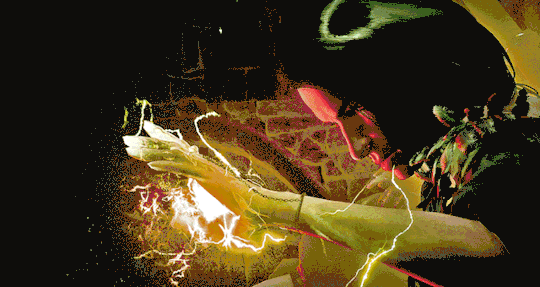
D R U I D S
This is interesting. Druids as I believe don't directly use magic, at least not when it's causing disbalance. Druids are masters of natural magic, they sense it everywhere, in every living and unliving natural thing. Animals, plants, stones, water; Everything what is opposed to the Nurture is under Druids control.
They don't cast spells nor weave them. They just know "tricks". "Tricks" that will allow them to turn into animals, to command tree roots, to heal wounds. They unlock the nature part of their magical potential and just use those abilities as if they always could do that, as if they unlocked innate powers.
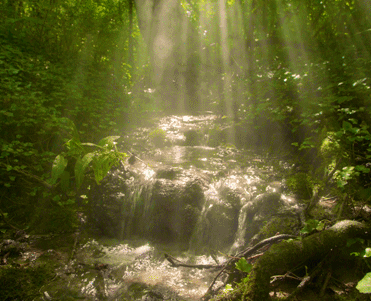
M O N K S
Monks are close to Druids in concept, but instead of unification with nature, they seek peace inside their souls.
A great monk unlocks their innate powers through discipline, high morals and inner peace. Think anyone from Kung-Fu Panda: they all have some sort of inner peace with themselves, and many are capable of inhumane feats, such as incredible fighting skills, chi stealing, paralysing or healing.

W A R L O C K S
Warlocks are sort of tricky. In my native language, they are called "dark(magic)book-ers", something like "users of dark magic who learn from dark magic books".
Their entire thing is they got their magic from a patron, a being of powerful nature that gifted them abilities of different kinds. They can learn to use the magical powers they were given as spells or incantations, but generally, these will just remain abilities. Think "opening unholy portals to hell so you can summon foul little demon minions" or "turn into a six-limbed monster cat with laser eyes" and such. Warlocks can lose their powers if they don't follow what their patron tells them to do, or can be punished by the patron severely, so much that their powers won't matter anymore afterwards.
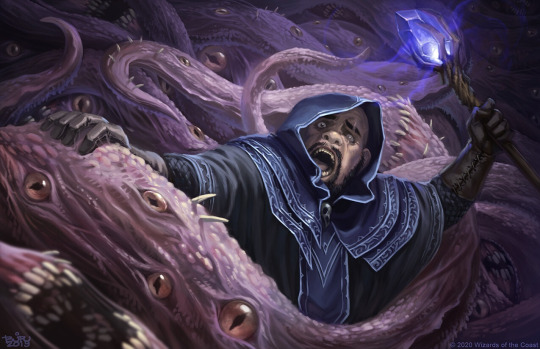
P R I E S T S
Priests are too, like Warlocks, getting power from a patron in a religious fashion. It is tricky to differentiate of course, and even as I am writing this I am unsure how to tell the difference.
There is one, though. While Warlocks had their abilities are given by the patron and it is not necessary for them to have innate magical talents, Priests have their abilities unlocked by their patron. Meaning they cannot be taken away if the Priest loses faith or betrays their patron, instead gaining negative effects for using them since they use their religion as a channel, and boy oh boy if their deity doesn't have it turned on at all times.
Priests are somewhat religious Mages, not bound by specific spells.
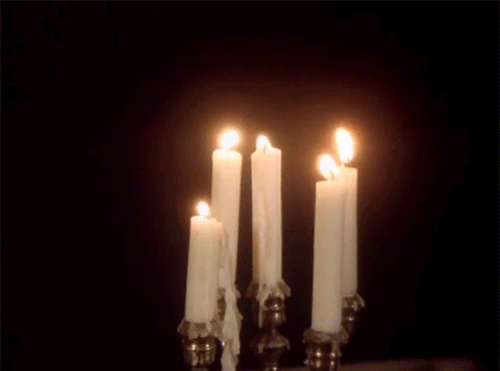
C L E R I C S
Clerics are the religious Wizards type. They are reading their holy books and repeat prayers, wield powerful encantations and follow the guiding hand of their patron while doing so.
Their gifts aren't gifts exactly. They can be magically talented, but the only way they will use this talent is to cast standard and limited spells provided by their god. And, importantly, these words will not lose their power if they ever were to betray their patron. They will know the key to the patron's locker of magical powers, and the only thing the patron can do is either smile from the irony or try to weaken/block such spells.
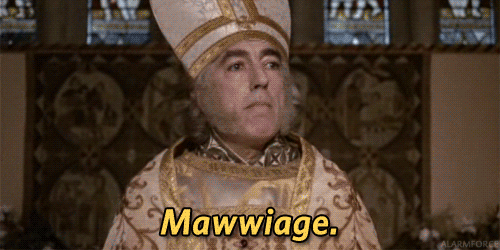
P A L A D I N S
This... Is difficult. Yes, they are pretty much like Priests and Clerics, yet they are way more gifted than them. They are something like the middle ground between the religious duo and Warlocks: they are something like pawns evolved into chess queens, upgraded by their patron, given, not unlocked, strenght and powers.
They follow the orders of their god, and will be punished if they decide to turn away from them. They made their choice, and their patron would be qutie dissapointed once betrayed. The results may vary, but I think at least part of the powers will stay with the Paladin - at least the spells.
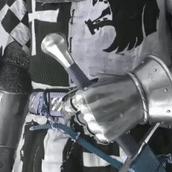
S H A M A N S
Shamans are too, quite quirky. But as I classificate them, I think they are somewhere in the middle between Druids and Warlocks.
Shamans are powerful masters of nature magic, but they are not bound to just that. They have a hint of Monks in them (spirituality), and usually have some sort of a patron (may it be a Spirit Animal or just any sort of spirit honestly). They can heal, they can harm; They can create, they can destroy - Shamans are not the keepers of balance, they are the keepers of the law of the jungle, of traditions, of history and myth.
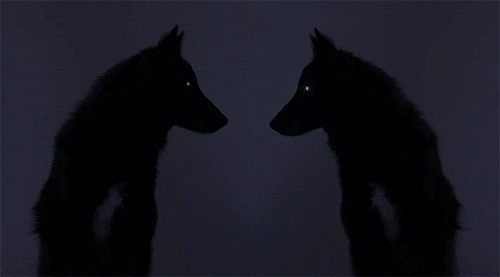
S A G E
Sage isn't really a caster type of a magic user. A sage is just a person of experience and wisdom, who knows the secrets of life and destiny.
Sages don't make guilds. Many don't even think themselves as sages even. They are just people whose words have a weight to them. Ones who see and understand. They can learn magic, sure, of any kind at that, but they will always be something like a lowkey Monk: in peace with themselves, and wishing to help others.

S O R C E R E R
Sorcerers are the talent type casters. They have so much magic in them they can't control it.
This magical potential can be tamed yes, but with very hard training and maybe some limitations (think Shadow the Hedgehog's rings). Sorcerers don't know how to cast spells, but they have some skills and encantations that are weirdly specific or powerful. Some sorcerers are planetouched, and are gifted with powers over the elements (think benders from ATLA). Or they have wild magic in their veins, causing strange and random stuff to happen at times. Maybe they are capable of using just this one specific spell of gargantuan power which even the greatest magic casters can't replicate, or maybe they have some sort of superpower due to their gift (think Encanto or X-men).
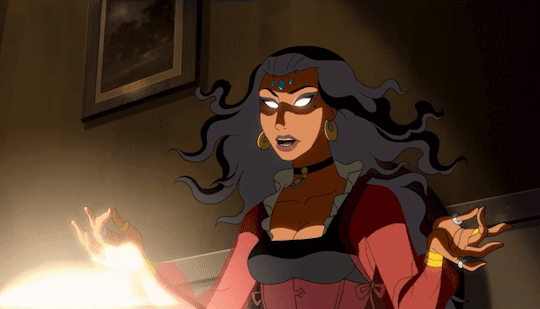
B L O O D H U N T E R S
This is the trickiest one. Basically, think self-corruption for a greater good. It's like a Warlock, but usually without a patron. It is somewhat Sorcerer, but their innate potential is mixed with training and education of a Mage or Wizard.
In my opinion, Geralt of Rivia is one very clean example of a bloodhunter. Has innate potential (seventh son of a seventh son), has training (in Kaer Morhen), was "corrupted" (witcher elixir) and fights for a greater good. He is somewhat "evil", "dark" or "grim", but more in an antihero sort of way.
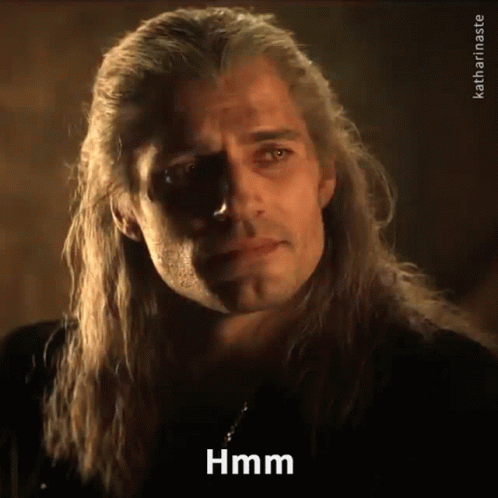
A R T I F I C E R S
Artificers are not exactly magic users. Their powers are granted not through patrons, not through training but through artifacts. It might be a badass sword (King Arthur?) enchanted armour (Ironman?) or pretty much everything.
Sad thing about Artificers is that without their artifacts, they are pretty much nothing. I say "pretty much" because to me, they are still a threat. Artificers are not just users of artifacts - they can be their creators. For this they will need some magic components, sure, but as such, they are to be feared in any situation.
Basically they are not-quite magically gifted people who study magic and it's physical implementations, such as runecircles and sigils, enchantments, alchemy and many more.
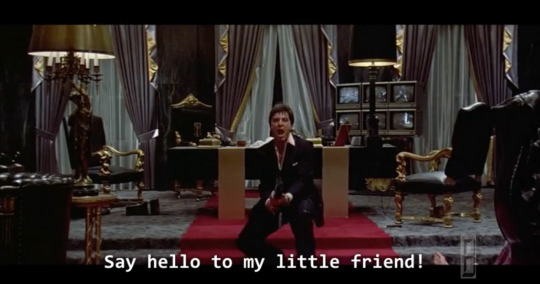
(Pictured: an artificer when threatened in their natural habitat)
S T A G E M A S T E R S
Even though Houdini wasn't a magic user, he was considered unnatural and mystical. A stage performer, an illusionist; Those people's magic is in the secret, in the way they trick people into thinkin they actually have magical powers while using nothing but tech.
I mentioned them just for a good measure, to illustrate what they basically are. They are sort of Artificiers, sort of Thiefs (regarding their sleight of hand) but almost never true mages. There could be a trope where a stagemaster is actually a magical caster of sorts, but it only adds an additional level of mystery. How do you make magic look like mundanity looking like magic?

Of course I will stay silent about the "battle-" modification for classes; A battlemage is a mage specifying in fighting, Battlewizard might know a couple of harmful spells to aid in battle (making them slightly similar to Bloodhunters but without the corruption bit). Generally any sort of battlecaster is just capable of using their magic quicker and on the go while in battle. Hop - and the enemy is petrified, turned to pebbles by a smash of a hammer seconds later; Shazam - and a trench instantly forms before your feet, swallowing a line of the incoming enemies and giving you the high ground advantage (*cue to Obi-Wan heavy breathing*).
Now we are done! I think I touched every matter, so please let me know if I forgot something; It might be that some classes are just variations of the already listed ones of course.
And so, I can show you the several criteria of classes classification:
-> Source of power.
-> Way of using said power.
And that's basically it. You can get your power from innate talents, unlocked sources of energy inside of you, from a patron, artifacts or some sort of mutation (Witcher elixirs).
The way you use it of course is different too. You can read spells out loud or can weave your own incantations, aka Bookworm versus Freestyler.
Sorry for a long post and here's a sweet potato:

#worldbuilding#fantasy lore#fantasy worldbuilding#fantasy#fantasy world#dnd#worldbuilder#worldbuilding ideas#world creation#worldbuilder tips#worldbuilding tips#world builder#magic system#worldbuilding lore#worldbuilding assumption#magic categories#casters#caster idea#caster#long post
24 notes
·
View notes
Text
World Building Checklist
Have you ever started writing a story and realized your world has a bunch of unexplained shit and you have to fill in the gaps as you go? Me too, buddy. Me too. Here’s a checklist so that you can fully flesh out your world to the max. (I’m dying)
How does Time work? (Minutes, hours, days, the daylight cycle, years, ect.)
Species (if Fantasy. Will probably make another post on this.)
Countries, Nations, Tribes, ect. (nationalities/ races. Will probably make another post on this.)
The geography of the world (draw a map. Doesnt have to be good. Just for a general idea.)
Rivalries between races (includes prejudice, racism, ect.)
Religions
Technology
The Magic system. (Will probably make a whole other post on this.)
animals, plants, ect.
The sky: Sun, Moon(s), Stars, Constellation, Are there rings? (If the planet has rings)
Educations system
Government system
Politics
Methods of transport (Vehicles)
Medicine
Can’t really think of anything else. If you have more to add then reblog and add to the list! :) bye bee
#writing advice#how to write#creative writing#writers on tumblr#writing#writeblr#world#world building#fantasy worldbuilding#fantasy writing#fantasy tips#Fantasy world building tips#Writing tips#HEAVENLYRAIN’S WRITING TIPS
2K notes
·
View notes
Text
a list of 100+ buildings to put in your fantasy town
academy
adventurer's guild
alchemist
apiary
apothecary
aquarium
armory
art gallery
bakery
bank
barber
barracks
bathhouse
blacksmith
boathouse
book store
bookbinder
botanical garden
brothel
butcher
carpenter
cartographer
casino
castle
cobbler
coffee shop
council chamber
court house
crypt for the noble family
dentist
distillery
docks
dovecot
dyer
embassy
farmer's market
fighting pit
fishmonger
fortune teller
gallows
gatehouse
general store
graveyard
greenhouses
guard post
guildhall
gymnasium
haberdashery
haunted house
hedge maze
herbalist
hospice
hospital
house for sale
inn
jail
jeweller
leatherworker
library
locksmith
mail courier
manor house
market
mayor's house
monastery
morgue
museum
music shop
observatory
orchard
orphanage
outhouse
paper maker
pawn shop
pet shop
potion shop
potter
printmaker
quest board
residence
restricted zone
sawmill
school
scribe
sewer entrance
sheriff's office
shrine
silversmith
spa
speakeasy
spice merchant
sports stadium
stables
street market
tailor
tannery
tavern
tax collector
tea house
temple
textile shop
theatre
thieves guild
thrift store
tinker's workshop
town crier post
town square
townhall
toy store
trinket shop
warehouse
watchtower
water mill
weaver
well
wind mill
wishing well
wizard tower
#worldbuilding#setting prompts#writer resources#writing inspiration#writing prompts#scene settings#writing reference#writing ideas#prompt list#creative writing#writing community#writer prompts#writing tips#world#fantasy world#fantasy worldbuilding#high fantasy#world building#epic fantasy#writing fantasy
2K notes
·
View notes
Text
Let's talk about worldbuilding.
Worldbuilding is a crucial aspect of writing fiction, particularly in genres like fantasy and science fiction.
Remember that worldbuilding is a dynamic process that evolves as you write. Don't be afraid to experiment and make changes to your world as needed to serve the story.
Here are some tips to help you build a rich and immersive world:
Start with a Core Concept: Every world begins with an idea. Whether it's a magic system, a futuristic society, or an alternate history, have a clear concept that serves as the foundation for your world.
Define the Rules: Establish the rules that govern your world, including its physical laws, magic systems, societal norms, and cultural practices. Consistency is key to creating a believable world.
Create a Detailed Map: Optional, but helpful. Develop a map of your world to visualise its geography, including continents, countries, cities, and landmarks. Consider factors like climate, terrain, and natural resources to make your world feel authentic.
Build a History: Develop a rich history for your world, including key events, conflicts, and historical figures. Consider how past events have shaped the present and influenced the cultures and societies within your world.
Develop Cultures and Societies: Create diverse cultures and societies within your world, each with its own beliefs, traditions, languages, and social structures. Explore how different cultures interact and conflict with one another.
Flesh Out Characters: Populate your world with memorable characters who reflect its diversity and complexity. Consider how their backgrounds, motivations, and personalities are shaped by the world around them. (See my post on character development for more!)
Consider Technology and Magic: Determine the level of technology and the presence of magic in your world, and how they impact daily life, society, and the overall narrative.
Think about Economics and Politics: Consider the economic systems, political structures, and power dynamics within your world. Explore issues like inequality, governance, and social justice to add depth to your worldbuilding.
Show, Don't Tell: Instead of dumping information on readers, reveal details about your world gradually through storytelling. Show how characters interact with their environment and incorporate worldbuilding seamlessly into the narrative.
Stay Consistent: Maintain consistency in your worldbuilding to ensure coherence and believability. Keep track of details like character names, historical events, and geographic locations to avoid contradictions.
Leave Room for Exploration: While it's essential to have a solid foundation for your world, leave room for discovery and exploration as you write. Allow your world to evolve organically and be open to new ideas and possibilities.
Revise and Edit: Carefully review your worldbuilding to identify any inconsistencies, plot holes, or contradictory elements. Pay attention to details such as character backgrounds, historical events, and the rules of your world's magic or technology. Make necessary revisions to resolve any issues and maintain the integrity of your worldbuilding.
Happy writing!
#writeblr#writing#writing tips#writing help#writing resources#writing advice#worldbuilding#fantasy worldbuilding#creative writing
625 notes
·
View notes
Text
Something I've found is that if you want to develop really deep and rich worldbuilding, you've got to put your main or favorite characters out of your mind for awhile and look at things from other people's perspectives. What's the world like for the people who've never heard of your main/favorite characters, or have maybe heard of them, but mostly feel indifferent about them? How is the world affecting them, and how are they responding to it? If you shift your focus away from your main/favorite characters and start looking closely at everyone else, you're going to find some incredibly interesting things.
2K notes
·
View notes
Text
Want to worldbuild like a pro??
(📖 Master tips and everything I know📖)
Hello writers! You don't know how to worldbuild? Don't know where to start explaining the world you have created? Don't worry, you are in the right place! I have been there myself, and after many research (and even more trial and error) I have put together a list of the best worldbuilding tips I have encountered, and also created some of my own. (I know the first one is kind of overheard, but trust me).
Don't start right away with worldbuilding. A long paragraph about how your world works and its history might overwhelm new readers. A lot of other writers suggest waiting and learning about the world at the same time the protagonist does, or if that doesn't work for your story, dropping bits of information while the story moves forward. However, if you want to give a sense of how your world works from the start...
Exposition through action. This is my favorite method, and it helps a lot if you don't want to pause your story to info dump about the world you have created. Instead, this method relies on explaining the world and its dynamics while you continue with the narrative, briefly. For example: "As always, you couldn't see any trees in the meadow. The king had ordered years ago to cut each one of them because of a prophecy that foretold that the last dragon egg would lay in an oak."
Use expressions that reference normality or routines. In the last point, we used "as always", but there are tons of expressions you could use in your writing. This helps the reader understand what is the norm in this new world and what things are common, to later detect something that is not within that norm (or sometimes just to understand the world and its traditions better).
Use flashbacks when necessary. If you need to explain a very specific or detailed topic, I suggest using a flashback scene, that will help the reader understand with the narration and dialogue, instead of just explaining it to them. It makes for a more dynamic learning experience. But, at the end...
Do whatever will intrigue you. Some readers even like info dumps, and there is not one correct way to show your world. If it would make you curious, go and do it, wether people say it's correct or not. There are a lot of successful books that randomly stop to explain something about the world, and there is nothing wrong with that if you like it.
Hope you find this list useful, and as always happy writing :)
Also, if you are interested in tips or more examples of a specific topic, you can always leave a question in my ask. I'd be glad to answer it!!
Other tips for writers: previous
#writeblr#writing#writer#writers#writers on tumblr#writerscommunity#writers of tumblr#creative writing#current wip#world building#worldbuilding#tips for writers#tips#writing tips
438 notes
·
View notes
Text
How to Use Meal Scenes to Develop Characters, Relationships, and Your World

Worldbuilding can sound complicated, but why not make it a little more simple by focusing on food? It may be the domestic touch you need! NaNo Participant Lacey Pfalz talks about using meal scenes to develop your world and your characters.
There’s one thing that remains a universal human truth: we love food! While our perspectives on food might differ, people all across the globe gather together during mealtimes — and thus, mealtimes are made memorable.
Meal scenes can also help your story in a few key ways, especially if it’s fantasy, science fiction or historical fiction.
Meal Scenes for Worldbuilding
If we’re using food for worldbuilding purposes, does that mean we can say we’re worldcooking?
Just kidding! Worldbuilding, especially in historical fiction, science fiction, and fantasy, is an integral part of what you must do as a writer (In truth, it’s also important for writers from other genres, but we’re specializing in these three today).
Meal scenes can be an important part of the worldbuilding process. Food is intrinsically tied to a culture or a country, or even a small region. That’s why it’s important, when building your own world, to take time to figure out the bare minimum of what your characters will be eating.
Let’s do an example. Your world is fantasy, your kingdom set beside a wide river. Perhaps your capital city, where much of the action is located, is surrounded by wetland.
If this is the case, what types of food would likely grow there? Seafood, fished from the large river, might be your characters’ staple proteins, while rice might grow better than another grain because of your kingdom’s wetlands. Fruit, perhaps even coconuts, might be the sweet stuff your main character loves to devour.
Remember that your world directly affects what types of food your characters will be having: is there coffee in space? What about in Byzantine Turkey or your new riverside kingdom?
Shannon Chakraborty does a phenomenal job with this in her fantasy series The Daevabad Trilogy, which is set in the eighteenth century across the Middle East. Her first book, The City of Brass, is especially good at showcasing the often-fragrant dishes of the various cultures across this region of the world (some copies of the book even have a short list of recipes from the book that foodies can try whipping up for themselves).
While her book is set within the fantastical world of the Djinn, her food is based upon recipes that have been preserved for centuries.
There’s one small reminder with all of this: it’s important not to get too caught up in describing each dish so much that you end up taking the focus away from the characters in a meal scene. Meal scenes can be breaks from fast action, but they should also continue the plot.
Meal Scenes for Developing Characters & Relationships
Character development can be hard, especially if you have a handful of characters that you love! But in order to make your readers love them too, you have to show them interacting with the world around them.
That guy we love to hate? Maybe he’s a loner who has grown up eating by himself. Having him forced to sit and eat with a group of people who have known each other for years might be an awkward moment for him, but it helps readers to learn more about his own worldview — and it might just help get him out of his shell, or at least off the love-to-hate list.
Besides helping you develop a single character, writing meal scenes with some of your characters can also help readers learn more about the relationship between your characters.
Let’s say you have your main character, MC. MC leans over and steals a French fry from her best friend. There’s no issue, right? That’s because they like each other, and the best friend has likely eaten with MC before, and knows she enjoys stealing food from other people’s plates.
But when MC tries it again, this time with the guy sitting next to her, he whacks her hand to stop her from stealing. This sparks an argument that seems, at least to everyone else watching it, pointless, but readers will know from the rest of the story that they’re the enemies-to-lovers trope. This argument is just one of many before they finally acknowledge their feelings towards one another.
See how that worked? A meal scene wasn’t useless; it pulled the story along by giving readers another taste of the enemies-to-lovers trope that so many enjoy reading.
If you need a more visible example of how this can play out, try watching a movie like Pride & Prejudice, (the book is amazing, but I’m suggesting the movie as a visual aid). The movie does a great job showcasing just how different the members of the Bennet family are individually, how they act around each other, and how they act around company.
There’s often little action in meal scenes, so they’re not meant to be overused. The plot should also still be there — take the cringey proposal scene between Mr. Collins and Elizabeth in Pride & Prejudice, for example, which follows directly after a meal when the rest of her family abandons her. In this case, the plot (and Mr. Collins’ advances) ruin her meal.
Perhaps your meal scene is the much-needed respite in between battling fierce aliens for planet Earth, or the first time your main character’s enemy-to-lover has entered her home. Either way, meal scenes are an important way to immerse your readers in what kind of world they’re imagining as well as showcasing how your characters act and — more importantly — how they act around each other.

Lacey Pfalz is a travel journalist by day, hopeful author by night. She belongs to the class of graduates she dubs the Class of COVID-19, having graduated with a double major in history and writing at Wisconsin Lutheran College in 2020.
Her writing passions include fantasy, science fiction and historical fiction (with a little bit of romance, of course!). As someone with a physical disability, it’s her dream to write a fantasy series featuring a main character like her.
Header Image by Jack Sparrow
#nanowrimo#writing#writing tips#worldbuilding#characters#character relationships#by nano guest#lacey pfalz
1K notes
·
View notes
Text
25 ɦσƭ ƭɦเɳɠร σɳℓყ ɦσƭ ૮ɦα૨α૮ƭε૨ร ∂σ
[Title Reads: 25 Hot Things Only Hot Characters Do]
Rolling up their sleeves
Pulling clothing off of themselves or other characters with a single hand
Using nicknames
Protecting other characters from harm even when they know they'll get hurt
Holding Character A's chin, thigh, or back
Never sharing personal secrets with others
Lip biting
Staying behind Character A with their arms wrapped around their waist or turning them around
Kissing them indirectly with a piece of paper/hand/mask in between their lips
Softly rubbing a spot on Character A's body that hurts
Tucking, brushing, braiding, and patting Character A's hair
Catching other characters giving Character A a dirty glare and then Character B does it back at them
Being above Character A as the other is kneeling before them
Remembering key details about other characters like what they like, how they interact, their reactions...
Feeding Character A and then eating from the same spoon or drinking from the same cup at the exact location where A's lips were
Reminding their friends they care about them
Becoming what they need to be in certain circumstances
Putting Character A's head onto their lap
Catching A when they fall
Winking, nudging with an elbow, playful surprises
Telling the truth even when it hurts
Teasing Character A for almost everything and then pushing them against the wall with their lips pressed together
Eagerly waiting for Character A to appear
Grabbing Character A's chair and pulling them closer
Not just being a cold-hearted person and developing empathy for others
~~~
MASTERLIST
#writing prompt#imagine your otp#pining prompts#enemies to lovers#cute prompts#character features#writing help#writing tips#writing inspiration#writing#writing ideas#worldbuilding#otp#otp prompts#otp scenarios
1K notes
·
View notes
Text
Geology and the Economy/Trade in Your Fictional World: Explained
Hi, I'm Bird. I am a geology Ph.D. student and I love reading fiction and playing videogames, however something that can really pull me out of a fictional universe is a lack of understanding of basic geology, and how that would influence your fictional world. Today I will cover geology that can effect trade, some landscape features, and construction!
Things that are typically necessary/desired in a fictional world are building materials, gemstones/precious metals, and fossil fuels/ sources of energy. However, a lot of these things are not found together, and they typically have some features to make them more distinct in terms of landscape, so lets talk about it!
Gemstones/ Precious metals and landscape features
Typically, gemstones can be found in two different rock types. The first is intrusive igneous rocks (magma that slowly cooled underground to form course-grained rocks like granite) and high grade metamorphic rocks (rocks that got put under intense heat and pressure under the earth's surface). Some minerals are more likely to form in particular conditions than others, but for the most part these minerals can be found interchangeably within both of these places. *Note: this is a gross oversimplification but we are starting small
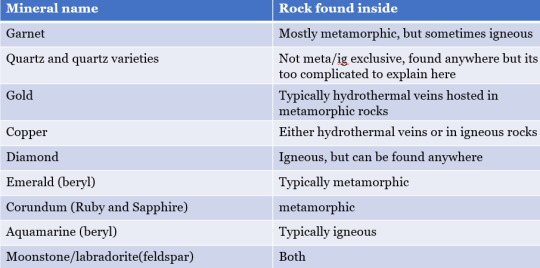
(Yes it is a shitty chart better pictures will come further in the post)
If you are writing these minerals based off and igneous deposit, good descriptions for the rocks would be speckled, with mineral grains of about the same size and varying in color. They should NOT be striated, and they will often form bald (unforested) cliffs that are typically rounded and not jagged.
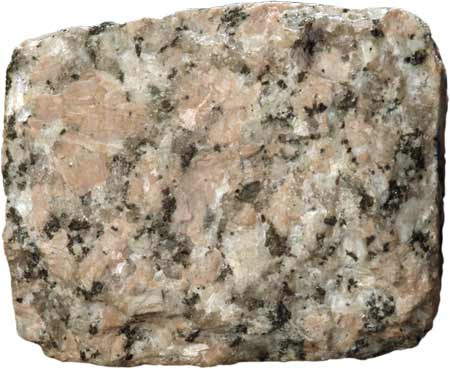

If you are writing with metamorphic rocks, you would expect these rocks to be layered, typically having light and dark layers with some minerals possibly being much larger than the others surrounding it. These textures can definitely (sometimes) be observed from a distance.

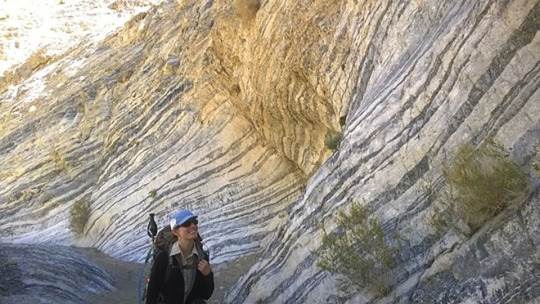
*Final notes about minerals* Quartz varieties are difficult, quartz can be found in volcanic, metamorphic, sedimentary, and intrusive igneous settings. If you are writing about agate specifically it is almost always volcanic in nature.
Diamonds are found in volcanic ash deposits called kimberlites, these deposits can occur in any rock type, so while they are igneous, they can be found anywhere. They have zero connection to the surrounding rocks.
2. Fossil Fuels
If a region is producing oil or coal, it is going to be from a sedimentary environment that is very rich in ancient plant material (like millions of years old). A unique feature of these locations would be finding lots of plant fossils, and rocks that can be found in association with these would be sandstone, shale, conglomerates/breccias, and limestones. Sedimentary rocks form in layers, so if exposed the layers will be very visible from a distance. You can also get unique features due to preferential weathering (fancy way of saying some rocks are harder than others, so when exposed to the same weather some rocks will break down faster than others). Also, natural oil seeps are a thing in places where natural oil is prevalent, but I couldn't find a good picture sorry.
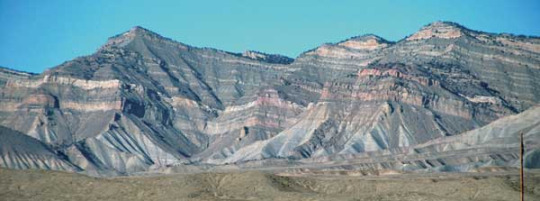
3. Building Resources
based on the rocks found in each region, the buildings will be made out of different materials, so lets breakdown what building materials would be used based off what rocks are present in the location.
Sedimentary rocks- lots of options here, so I will just info dump. If the region is drier, limestone is a good choice, historically may desert areas use limestone, it is soft and easy to carve, but it will dissolve slowly with rain. Sandstone is a durable rock that can be used, but it is very hard as it is made of quartz. Clay! shale breaks down in humid environments and will often make clay, this is a great, amazing building resource that could drive economy.
Metamorphic rocks- Marble.... if you want to make luxurious marble temples, metamorphic rocks are a must! Other comments, metamorphic rocks will often have layers of weaker minerals and stronger minerals, that means they will break along a defined surface. A lot of older houses in the Italian Alps (Aosta Valley) use these rocks for roofing. Slate roofing is also common in a lot of places, slate is formed from really low grade metamorphism, so this resource can be available in both sedimentary and metamorphic locations within reason.
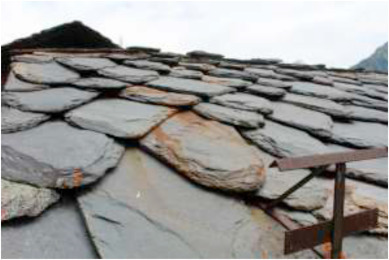
Igneous- Granite (light) and Gabbro (dark) is very hard and therefore it is used frequently in countertops today. This is also important because these rocks will take a high shine from polishing. Igneous rocks are also perfect for making cement! Volcanic ash mixed with quicklime and salt water is the recipe for roman concrete which is arguable much better than current day concrete but otherwise doesn't offer much more benefit.

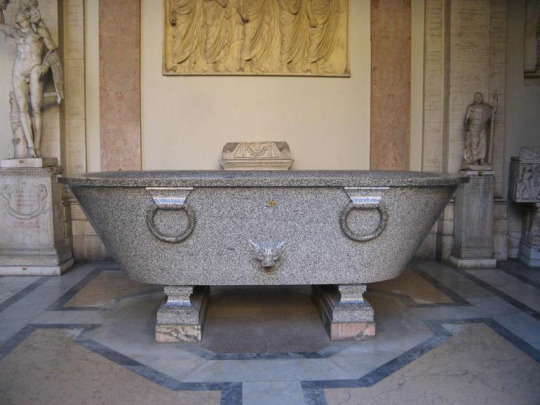
Thank you if you made it this far, I want to make more guides in the future to hopefully cover more geology topics that can influence a story (possibly natural disasters and associated landscape features for subtle foreshadowinggggg)
This guide is very simplified! It is supposed to cover a lot of information for people who may not know a lot about geology, but are interesting in creating fictional universes! If you know a lot about geology already, please avert your eyes, or comment something additional!
#geology#rocks#science#creative writing#dnd#worldbuilding#writeblr#fictional world#dnd worldbuilding#writerscommunity#writing resources#writing tips#writing prompt#stem#worldbuilding stuff
498 notes
·
View notes
Text
some misc worldbuilding questions to get your gears turning:
Do they have germ theory or some equivalent? How do they conceptualize the spread of disease and infection?
Is the everyday economy based more on trade/barter or currency? Is the currency valuable in its own right, or is it just something agreed upon to have value (eg. salt or gold vs. paper money)
What is their main method of lighting? What resources does this use?
Primary mode of transportation? How much does this vary based on things like purpose of travel, social class, etc.?
How much of a knowledge/education gap is there between social classes? Is there a baseline of education that everyone gets/is expected to have?
What are the most popular modes of storytelling? Is everyone telling campfire stories? Are they going to plays? puppet shows? are they going to the cinema? are they reading novels or epic poetry? Are there any folk characters or pop culture things that most people are familiar with?
Where does most people's moral framework primarily come from? Religion? Philosophy? Are there different schools of thought? How much do they vary?
Is there anything considered scandalous/improper/taboo that's normal in your own culture? and vice versa
Do most people live and die where they are born, or is it common to relocate and travel widely? how much does this vary by class/profession/region?
What do they do with criminals? Do they have an extensive prison system? If so, who funds/runs it? If not, how is crime discouraged/managed? Are there specific punishments for specific crimes?
How rigid are their class boundaries? How possible/common is it for someone to change social classes?
Is there anything that people get dangerously addicted to in your world? How accessible is it?
How easy is it for someone to do research/look up information they don't know? What is the primary method of doing this?
What holidays do they have? Any weird traditions? Fun traditions? Are they universally celebrated, or only by specific groups of people?
How do they dispose of their dead? How do they honor their dead?
How much exchange is there between cultures? Do people of different groups intermingle, or do they mostly stick with their own people?
How common is it to speak more than one language, and who is most likely to be multilingual?
How much do regional dialects/accents vary within the same language? Are there any dialects/accents that are stigmatized? Do different accents have different associated stereotypes?
This isn't meant to be taken as a checklist that you have to completely fill out btw. Just things that might help add flavor to your world and characters. (Also mostly things I end up thinking about logistically anyway as they become relevant to the plot or a character's frame of reference.) Enjoy!
498 notes
·
View notes
Text
A writer’s guide to the historical method: how historians work with sources
In this post, I provide a brief overview of how historians engage with different types of sources, with a focus on the mindset of a historian. This insight could be valuable for anyone crafting a character whose profession revolves around history research. It may also prove useful for authors conducting research for their book.
Concept of historical source
The concept of historical source evolves over time.
Initially, the focus was mainly on written sources due to their obvious availability. However, as time has progressed, historians now consider a wide range of sources beyond just written records. These include material artifacts, intangible cultural elements, and even virtual data.
While "armchair historians" may rely on existing studies and secondary sources, true professional historians distinguish themselves by delving directly into primary sources. They engage in a nuanced examination of various sources, weaving together diverse perspectives. It's crucial to recognize the distinction between personal recollection or memory and the rigorous discipline of historical inquiry. A historical source provides information, but the truth must be carefully discerned through critical analysis and corroboration.
Here's a concise list of the types of sources historians utilize:
Notarial source
Epistolary source
Accountancy source
Epigraphic source
Chronicle source
Oratory and oral source
Iconographic source
Diary source
Electronic source
Example: a notarial source
These are documents drafted by a notary, a public official entrusted with providing legal certainty to facts and legal transactions. These documents can take various forms, such as deeds, lawsuits, wills, contracts, powers of attorney, inventories, and many others.
Here we are specifically discussing a lawsuit document from 1211 in Italy.
A medieval lawsuit document is highly valuable for understanding various aspects of daily life because in a dispute, one must argue a position. From lawsuits, we also understand how institutions truly operated.
Furthermore, in the Middle Ages, lawsuits mostly relied on witnesses as evidence, so we can access a direct and popular source of certain specific social situations.
Some insight into the methodology of analysis:
Formal examination: historians scrutinize the document's form, verifying its authenticity and integrity. Elements such as structure, writing style, language, signatures, and seals are analyzed. Indeed, a professional historian will rarely conduct research on a source published in a volume but will instead go directly to the archive to study its origin, to avoid transcription errors.
Content analysis: historians proceed to analyze the document's content, extracting useful information for their research. This may include data on individuals, places, events, economic activities, social relations, and much more. It's crucial to compile a list of witnesses in a case and identify them to understand why they speak or why they speak in a certain manner.
Cross-referencing with other sources: information derived from the notarial source is compared with that of other historical sources to obtain a more comprehensive and accurate view of the period under examination.
Documents of the episcopal archive of Ivrea
Let's take the example of a specific legal case, stemming from the documents of the episcopal archive of Ivrea. It's a case from 1211 in Italy involving the bishop of Ivrea in dispute with Bongiovanni d'Albiano over feudal obligations.
This case is significant because it allows us to understand how feudal society operated and how social status was determined.
The bishop's representative argues that Bongiovanni should provide a horse as a feudal service. Bongiovanni denies it, claiming to be a noble, not a serf. Both parties present witnesses and documents supporting their arguments.
Witnesses are asked whether the serf obligations had been endured for a long time. This helps us understand that in a society where "law" was based on customs, it was important to ascertain if an obligation had been endured for a long time because at that point it would no longer be contestable (it would have become customary).
The responses are confused and inconsistent, so witnesses are directly asked whether they consider Bongiovanni a serf or a noble. This is because (and it allows us to understand that) the division into "social classes" wasn't definable within concrete boundaries; it was more about the appearance of one's way of life. If a serf refused to fulfill his serf duties, he would easily be considered a noble by bystanders because he lived like one.
Ultimately, the analysis of the case leads us to determine that medieval justice wasn't conceived with the logic of our modern system, but was measured in oaths and witnesses as evidentiary means. And emerging from it with honor was much more important than fairly distributing blame and reason.
Other sources
Accounting source: it is very useful for measuring consumption and its variety in a particular historical period. To reconstruct past consumption, inventories post mortem are often used, which are lists of goods found in households, described and valued by notaries to facilitate distribution among heirs.
Alternatively, the recording of daily expenses, which in modern times were often very detailed, can lead to insights into complex family histories and their internal inequalities - for example, more money might be spent on one child than another corresponding to their planned future role in society.
Oral source: in relation to the political sphere, it is useful for representing that part of politics composed of direct sources, that is, where politics speaks of itself and how it presents itself to the public, such as a politician's public speech.
However, working with this type of source, a historian cannot avoid hermeneutic work, as through the speech, the politician aims to present himself to a certain audience, justify, persuade, construct his own image, and achieve results. This is the hidden agenda that also exists in the most obvious part of politics.
Iconographic source: it concerns art or other forms of "artistic" expression, such as in the case of an advertising poster. They become historical sources when it is the historian who, through analysis, confers upon them the status of a historical source. Essentially, the historian uses the source to understand aspects of the past otherwise inaccessible.
The first step in this direction is to recontextualize the source, returning it to its original context. Examining the history of the source represents the fundamental first step for historical analysis.
Diary source: diaries are a "subjective" source, a representation of one's self, often influenced by the thoughts of "others," who can be close or distant readers, interested or distracted, visible or invisible, whom every diary author can imagine and hope to see, sooner or later, reflected on the pages of their writing.
Furthermore, they are often subject to subsequent manipulations, and therefore should be treated by historians only in their critical edition; all other versions, whether old or new, foreign or not, are useful only as evidence of the changes and manipulations undergone over time by the original manuscripts.
Electronic source: historians use Wikipedia even if they often don't admit it out loud.
This blog is supported through tips here on Tumblr. If you’d like to support me, please consider giving a tip.
#writing advice#writing help#writing reference#writing tips#creative writing#fantasy worldbuilding#fantasy writing#worldbuilding#worldbuilding tips
295 notes
·
View notes
Text
types of conflict - world building
person vs person
- between two people
- a hero and a villain
- the mc's goal is obstructed by another person
- Victor Hugo's les misérables
person vs technology
- a person faces technology
- between a person / group of people and an object of science
- technology refers to science over magic
- Mary Shelley's frankenstein
person vs nature
- a person faces nature
- the effects of nature on the human world
- the mc's goal (long- or short-term) is obstructed by an element of nature / a natural force
- John Green's a fault in our stars
person vs society
- a person faces a collective group of people
- a smaller group of people vs a large group of people
- their goal is obstructed by this group of people
- Suzanne Collins' the hunger games
person vs supernatural
- a person faces a supernatural subject
- this tends towards the magic, although similar to person vs. technology in a sense
- fate, magic forces, otherworldly beings, religion, deities
- Rick Riordan's Percy Jackson
person vs self
- conflict between a person and their inner self
- may be conflicted with their own feelings
- can have two opposing goals
- Fyodor Dostoevsky's crime and punishment
#world building#writerblr#lyralit#creative writing#writing#writers#writing ideas#readerblr#writing prompts#writers block#writing tips#writing resources#writing research#types of conflict#worldbuilding#wip
7K notes
·
View notes
Text
Fantasy Worldbuilding Questions (Society)
Society Worldbuilding Questions:
What is each society’s crowning achievement or proudest "claim to fame"?
What are each society’s greatest ills or challenges? (Do these differ depending on who you ask?)
Who garners the most respect in this society, and why?
Who is shown the least respect in this society, and why (what does it value)?
Where are hierarchies and power differences starkest between people in this world, and why?
Where are social norms and influences (such as laws) most stringently upheld in this world, and why (e.g., what roles do politics, ideology, religion, or competition for resources play)?
When did this society’s power structures emerge or change significantly, and why?
When did major societal beliefs or practices become entrenched? Are there any that have recently fallen away or started to disappear?
Why is living within this society challenging for your main characters?
Why does each character enjoy or appreciate this society, if anything?
❯ ❯ ❯ Read other writing masterposts in this series: Worldbuilding Questions for Deeper Settings
#writeblr#fiction writing#writing tips#writing advice#writing#novel writing#worldbuilding#writing research#fwq#society#social norms#greatest ills#now novel
624 notes
·
View notes
Note
I'm writing a sci-fi story about a space freight hauler with a heavy focus on the economy.
Any tips for writing a complex fictional economy and all of it's intricacies and inner-workings?
Constructing a Fictional Economy
The economy is all about: How is the limited financial/natural/human resources distributed between various parties?
So, the most important question you should be able to answer are:
Who are the "have"s and "have-not"s?
What's "expensive" and what's "commonplace"?
What are the rules(laws, taxes, trade) of this game?
Building Blocks of the Economic System
Type of economic system. Even if your fictional economy is made up, it will need to be based on the existing systems: capitalism, socialism, mixed economies, feudalism, barter, etc.
Currency and monetary systems: the currency can be in various forms like gols, silver, digital, fiat, other commodity, etc. Estalish a central bank (or equivalent) responsible for monetary policy
Exchange rates
Inflation
Domestic and International trade: Trade policies and treaties. Transportation, communication infrastructure
Labour and employment: labor force trends, employment opportunities, workers rights. Consider the role of education, training and skill development in the labour market
The government's role: Fiscal policy(tax rate?), market regulation, social welfare, pension plans, etc.
Impact of Technology: Examine the role of tech in productivity, automation and job displacement. How does the digital economy and e-commerce shape the world?
Economic history: what are some historical events (like The Great Depresion and the 2008 Housing Crisis) that left lasting impacts on the psychologial workings of your economy?
For a comprehensive economic system, you'll need to consider ideally all of the above. However, depending on the characteristics of your country, you will need to concentrate on some more than others. i.e. a country heavily dependent on exports will care a lot more about the exchange rate and how to keep it stable.
For Fantasy Economies:
Social status: The haves and have-nots in fantasy world will be much more clear-cut, often with little room for movement up and down the socioeconoic ladder.
Scaricity. What is a resource that is hard to come by?
Geographical Characteristics: The setting will play a huge role in deciding what your country has and doesn't. Mountains and seas will determine time and cost of trade. Climatic conditions will determine shelf life of food items.
Impact of Magic: Magic can determine the cost of obtaining certain commodities. How does teleportation magic impact trade?
For Sci-Fi Economies Related to Space Exploration
Thankfully, space exploitation is slowly becoming a reality, we can now identify the factors we'll need to consider:
Economics of space waste: How large is the space waste problem? Is it recycled or resold? Any regulations about disposing of space wste?
New Energy: Is there any new clean energy? Is energy scarce?
Investors: Who/which country are the giants of space travel?
Ownership: Who "owns" space? How do you draw the borders between territories in space?
New class of workers: How are people working in space treated? Skilled or unskilled?
Relationship between space and Earth: Are resources mined in space and brought back to Earth, or is there a plan to live in space permanently?
What are some new professional niches?
What's the military implication of space exploitation? What new weapons, networks and spying techniques?
Also, consider:
Impact of space travel on food security, gender equality, racial equality
Impact of space travel on education.
Impact of space travel on the entertainment industry. Perhaps shooting monters in space isn't just a virtual thing anymore?
What are some indsutries that decline due to space travel?
I suggest reading up the Economic Impact Report from NASA, and futuristic reports from business consultants like McKinsey.
If space exploitation is a relatiely new technology that not everyone has access to, the workings of the economy will be skewed to benefit large investors and tech giants. As more regulations appear and prices go down, it will be further be integrated into the various industries, eventually becoming a new style of living.
#writing practice#writing#writers and poets#creative writing#writers on tumblr#creative writers#helping writers#poets and writers#writeblr#resources for writers#let's write#writing process#writing prompt#writing community#writing inspiration#writing tips#writing advice#on writing#writer#writerscommunity#writer on tumblr#writer stuff#writer things#writer problems#writer community#writblr#science fiction#fiction#novel#worldbuilding
200 notes
·
View notes
Text
The Trick To Writing Filler
(TL;DR at the bottom)
Filler is when you spend a chapter padding the length of your story between plot-related events. Filler chapters have little to no impact on the overarching plot and can be self-contained, and thus in TV shows filler episodes are often reran the most as people unfamiliar with the show can casually watch without being confused without the knowledge of prior plot beats
So with the chapter being largely self-contained and acting outside of the plot, what do you use to make the filler chapter engaging? I’m going to use filler episodes from Avatar: The Last Airbender to provide examples
1. Worldbuilding. Zuko Alone depicts Zuko’s travels taking him through an Earth Kingdom village and becoming acquainted to the family that allows him to stay with them, especially their young son. He learns about what the Fire Nation’s impact on this village has been; destroyed houses, families torn apart, constant robbery and other abuses of power and injustices. And even after Zuko defends the villagers and his new friend, he’s venomously cast out from the village by even the little boy because he outed himself as a firebender. This episode explored the impact of the war on the people of the Earth Kingdom, the victims of war that have no involvement in it and no way of defending themselves from it
2. Character exploration. In The Beach, we learn more about Mai, Ty Lee, Azula and Zuko and how their own traumas and personal upbringings have impacted their personalities. For Zuko this is part of a turning point for him, but for the girls it’s more to understand why they are the people we’ve gotten to know over the seasons, especially Ty Lee and Mai. The episode also serves to showcase how Azula and Zuko are so out of place being just normal teenagers; Azula has no idea how to talk to her peers and no identity outside being Princess Azula of the Fire Nation, while Zuko’s hotheadedness and jealousy issues lead him to lash out and be far too confrontational and controlling for his own good. This episode isn’t really used to develop these characters, or at least not the girls, but instead explains and showcases their behaviours and the reasons behind them
3. Character development. Going back to The Beach, Zuko does indeed receive development rather than just character exploration like the girls do; he comes to understand that he’s not just angry at the world or angry in general, but angry with himself. This is a notable turning point for Zuko’s redemption arc, because he now understands fully that he truly regrets betraying Iroh and sacrificing his new start in life in favour of returning to the Fire Nation. He might not yet be fully decided on turning his back on Ozai, but without this moment I don’t know if he’d have gotten there, or at least not as quickly as he did
4. Relationship development. Sokka’s Master has a C plot of Aang, Katara and Toph all being rather bored and lost without Sokka’s presence. The A plot exploring Sokka’s feelings of inadequacy and uselessness in comparison to such powerful and formidable bending masters being contrasted with the Gaang unable to function without him already speaks volumes about their dynamics, but looking deeper into the C plot also shows how much value Sokka really does bring to the team; structure, planning, humour, a quick wit, strategic moves. The Gaang always supported Sokka and never seemed to view him as expendable outside of the occasional teasing, but having it acknowledged so clearly and plainly that they can feel a little aimless and flat without Sokka and being so delighted when he returns really shows us the kind of value Sokka brings to this team and brings us and the characters to further appreciate it
5. Downtime. The Ember Island Players depicts the characters taking a break to watch a comedic play based on their wacky adventures, only to be largely underwhelmed and displeased by how they’re portrayed. There are no stakes to this episode and barely any plot, just the Gaang taking a breather as they react to a bad play. This chance to relax and watch something inconsequential is just as important to the viewers as we’ve got the show’s finale in the next four episodes, which will be very plot-driven and intense. The Ember Island Players also has the additional viewer bonus of recapping the events of the show right before it all ends, giving the viewers time to reflect on the journey they’ve gone on with these characters. In order for the stakes to feel high and the tension to rise, there has to be downtime where there are low stakes and low tension; if things are intense all the time, the moments that are supposed to feel super intense will just feel average in comparison. Resetting that intensity right before such a big event while still acknowledging the looming threat coming soon will feel like the calm before the storm and allow your audience to soak it all up like the characters are
Wow, did I just go through all that without talking about Tales of Ba Sing Se? I’ll save that for another post if people are interested in more
TL;DR - filler provides a moment to breathe, reset the intensity levels the audience are experiencing and take a chance to step away from the external conflict (the overarching plot) in favour of worldbuilding and the characters within your setting. Small moments can amount to something big, and can help make large scale decisions or plot twists feel more build-up and in-character
#filler#worldbuilding#character development#avatar the last airbender#atla#writing#writers#writeblr#bookblr#book#writers on tumblr#writerscommunity#writers of tumblr#writer#how to write#on writing#creative writing#write#writers and poets#female writers#queer writers#writblr#writer things#writing tips#writerscreed#writing advice#writing life#writer stuff#writersnetwork#writer problems
382 notes
·
View notes
Text
Let's talk about writing fantasy.
Fantasy is one of my favourite genres, to read and to write. But the worldbuilding required and the existing tropes can make it difficult to craft a unique, compelling novel. There are a number of less-discussed nuances that might not always be at the forefront of writing discussions. Here are some tips to help you out:
Ground it in reality: Even though fantasy allows for boundless imagination, grounding your world in elements familiar to readers can make it more relatable and believable. Making it too otherworldly can make it difficult to understand or follow, and will likely make it much more difficult to interweave the explanation of your world and its society into the text seamlessly.
Consistency is key: Fantasy worlds can be complex, with their own rules, magic systems, and histories. Ensure consistency in your worldbuilding, avoiding contradictions or sudden changes without explanation. I find it helpful to keep a world bible or notes to track details and maintain coherence throughout the story.
Character-driven plots: While epic battles and magical quests are exciting, don't forget that compelling characters drive the heart of any story. Develop multi-dimensional characters with strengths, weaknesses, and personal arcs that resonate with readers (see my post on character development for more).
Avoid clichés and stereotypes: Fantasy often draws from familiar tropes and archetypes, but try not to rely on them too heavily. Subvert expectations and breathe new life into old conventions by adding unique twists or exploring lesser-known mythologies and cultures. Make it your own!
Magic has consequences: Magic adds wonder to fantasy worlds, but it should also have limitations and consequences. Consider the societal, environmental, and personal impacts of magic on your world and characters. A well-defined magic system can enhance the depth and realism of your story.
Worldbuilding through storytelling: Instead of dumping large chunks of exposition, reveal your fantasy world gradually through character interactions, dialogue, and plot progression. Show, don't tell, and let readers piece together the intricacies of your world as they journey through your story (check out my previous post on worldbuilding for more tips).
Embrace diversity: Fantasy worlds should reflect the diversity of our own world. Include characters from various backgrounds, cultures, and identities, and explore themes of inclusivity and acceptance within your narrative.
Conflict beyond good vs. evil: While the battle between good and evil is a classic fantasy trope, consider adding layers of moral ambiguity and complexity to your conflicts. Explore themes of power, redemption, and the consequences of choices made in the face of adversity.
Research is essential: Even in a world of imagination, research plays a crucial role in grounding your story in reality. Whether it's drawing inspiration from historical events, cultural practices, or scientific principles, thorough research can enrich your worldbuilding and add depth to your narrative. Even fantasy worlds and elements require some sort of basis to make them more believable.
Revise: Like any genre, writing fantasy requires extensive revision and polishing. Be prepared to revise your manuscript multiple times, seeking feedback from beta readers or critique partners to strengthen your story, characters, and worldbuilding.
Happy writing!
#writeblr#writing#writing tips#writing advice#writing help#writing resources#creative writing#plot development#worldbuilding#fantasy worldbuilding#fantasy#fantasy writing
158 notes
·
View notes